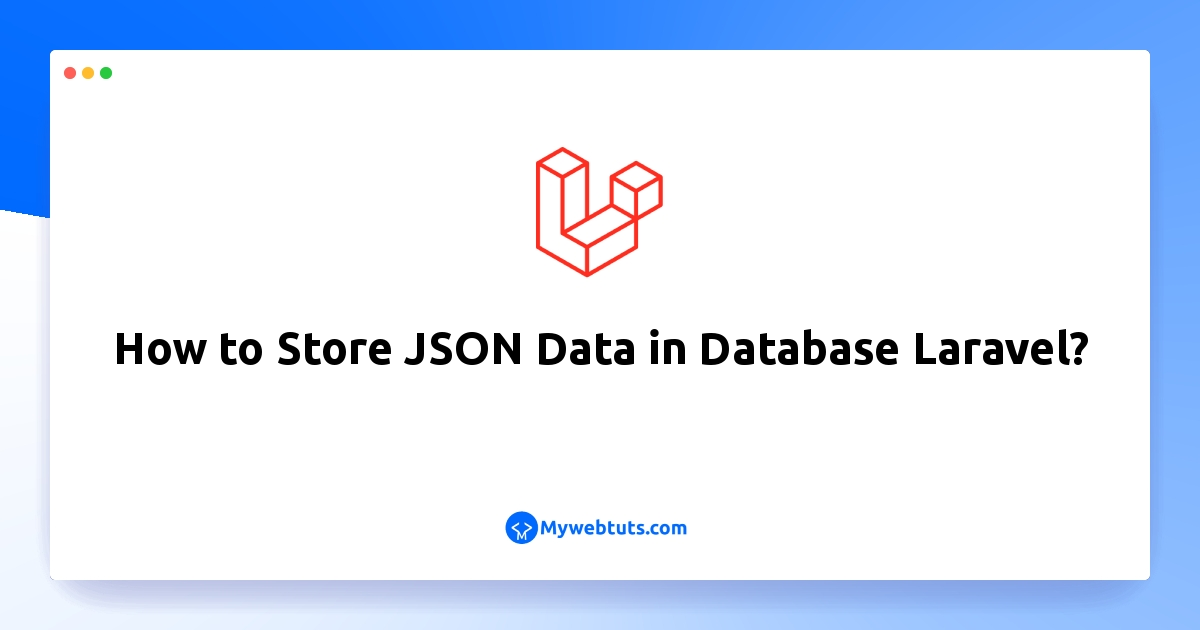How to Store JSON Data in Database Laravel?
Sep 12, 2022 . Admin

Hello Friends,
Here, I will show you how to work and how to store json data in the database laravel. I explained simply step-by-step laravel stores json in a database. you'll learn laravel to save json in a database. In this article, we will implement a laravel save json array to a database.
Sometimes, if we have large data or unfixed columns then we can not create too many fields in a database table with the nullable field. so we have to use JSON data type to store values, that way we can store large data or unstructured data. if you want to store a JSON array in a database in laravel then I will give you a simple example of how to store a JSON array store and access it from the database in laravel.
In this example, first, we will create migration with a JSON column. Then we will create a model with a getter and setter. when you create records then you can pass them as an array and when you get records then you will find an array. so let's see a simple example and learn it.
You can use this example with laravel 6, laravel 7, laravel 8, and laravel 9 versions.
You have just to follow the below step and you will get the layout as below:
Step 1: Install LaravelThis is optional; however, if you have not created the laravel app, then you may go ahead and execute the below command:
composer create-project laravel/laravel example-appStep 2: Create Migration
Here, we need create database migration for "items" table with title and data(JSON Column) columns and also we will create model for items table.
php artisan make:migration create_items_tabledatabase/migrations/2022_07_11_141714_create_items_table.php
<?php
use Illuminate\Database\Migrations\Migration;
use Illuminate\Database\Schema\Blueprint;
use Illuminate\Support\Facades\Schema;
return new class extends Migration
{
/**
* Run the migrations.
*
* @return void
*/
public function up()
{
Schema::create('items', function (Blueprint $table) {
$table->id();
$table->string('title');
$table->json('data')->nullable();
$table->timestamps();
});
}
/**
* Reverse the migrations.
*
* @return void
*/
public function down()
{
Schema::dropIfExists('items');
}
};
Then run migration command to create items table.
php artisan migrateStep 3: Create Model
In this step, we will create Item.php model with getter setter. let's create model and update following code:
php artisan make:model ItemApp/Models/Item.php
<?php
namespace App\Models;
use Illuminate\Database\Eloquent\Factories\HasFactory;
use Illuminate\Database\Eloquent\Model;
use Illuminate\Database\Eloquent\Casts\Attribute;
class Item extends Model
{
use HasFactory;
/**
* Write code on Method
*
* @return response()
*/
protected $fillable = [
'title', 'data'
];
/**
* Get the user's first name.
*
* @return \Illuminate\Database\Eloquent\Casts\Attribute
*/
protected function data(): Attribute
{
return Attribute::make(
get: fn ($value) => json_decode($value, true),
set: fn ($value) => json_encode($value),
);
}
}
Step 4: Create Route
In third step, we will create one route for testing. so create one route here.
routes/web.php
<?php
use Illuminate\Support\Facades\Route;
use App\Http\Controllers\ItemController;
/*
|--------------------------------------------------------------------------
| Web Routes
|--------------------------------------------------------------------------
|
| Here is where you can register web routes for your application. These
| routes are loaded by the RouteServiceProvider within a group which
| contains the "web" middleware group. Now create something great!
|
*/
Route::get('item', [ItemController::class, 'index']);
Step 5: Create Controller
In this step, we will create ItemController file and write index() method to create item records with array and access as array.
app/Http/Controllers/ItemController.php
<?php
namespace App\Http\Controllers;
use Illuminate\Http\Request;
use App\Models\Item;
class ItemController extends Controller
{
/**
* Write code on Method
*
* @return response()
*/
public function index()
{
$input = [
'title' => 'Demo Title',
'data' => [
'1' => 'One',
'2' => 'Two',
'3' => 'Three'
]
];
$item = Item::create($input);
dd($item->data);
}
}
Run Laravel App:
All the required steps have been done, now you have to type the given below command and hit enter to run the Laravel app:
php artisan serve
Now, Go to your web browser, type the given URL and view the app output:
http://localhost:8000/item
You can see database output and print variable output:
Output:
array:3 [ 1 => "One" 2 => "Two" 3 => "Three" ]
